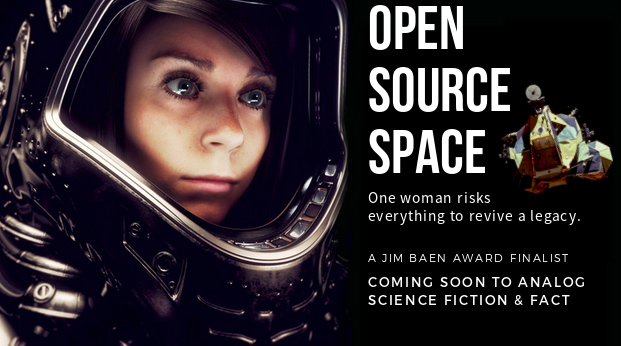With the launch of the Falcon Heavy, Space-x has demonstrated a booster half as powerful as the mighty Saturn V and three times as powerful as the next largest launch vehicle flying today:

With the promise of extensive reusability and rapid turnaround times, Space-X seems poised to re-write the economic rules of spaceflight. Are we finally going to see hotels in orbit and colonies on the moon? Well…maybe. Right now, it’s hard to see how anyone is going to compete, not the United Launch Alliance behind the Delta IV Heavy, not the Russians, not Blue Origin, and not NASA. But expect all that to change.
Hat’s off to Space-X and Elon Musk for the sort of innovation that’s been missing from launch vehicle design since the days of Werner Von Braun and Sergei Korolev. Grid fins and engine design ideas from the Russians contribute to performance and reusability. Use of kerosene (out of fashion since the Apollo days) allows for a smaller rocket, which is therefore lighter and more efficient than hydrogen fueled rockets (like the Shuttle and Delta V) even through hydrogen carried more energy per unit mass. Pre-chilling the fuel (not possible with hydrogen) makes the Falcon even more volume efficient. The result is that the Falcon 9 heavy can launch three times the payload of the Delta V Heavy, even through the falcon is slightly smaller and largely reusable.
This last point cannot be overestimated. Elon Musk has paid attention to something most of the rest of the industry has gotten wrong for decades: The goal in launch vehicle design is cutting the cost per pound to orbit. Specific impulse doesn’t matter. Energy content per pound of fuel doesn’t matter. Reusability, by itself, doesn’t matter. All the matter is, how much does it cost to get a pound into orbit.
The Space Shuttle tries to cut costs through reuse, but created a launch system so complex, it cost more to operate than contemporary expendables (like the Delta IV Heavy). Space-X instead, looked at the math in economic terms. It is amazing that in so doing, they’ve created a launch vehicle that is far more economical than any alternative, even though it has to hold back some of its fuel for the ride home.
Kudos. Mr. Musk. He also understands that rockets become more economical the larger they are. I don’t know if his “BFR” is going to carry colonists to Mars, but one thing I do know. There has been a sea change in space flight, and every player must now keep up or get out of the game. The result, likely, will be honeymoons in orbit sooner than you might think.
Bid welcome, dear followers, to Molly Elizabeth Atkins, 2017 Writers of the Future published finalist, and my guest today on the blog.
Stuart: Welcome Molly! Tell us a little about yourself!
Molly: I live in St. Louis with my husband and two daughters who are 5 and 9 years old. I’m originally from Texas, and I grew up in College Station. That’s where Texas A&M University is, so while some kids had summer jobs mowing lawns or working in food service, my summer jobs were things like shelving books in the university library and working in the university’s various labs. I always love it in job interviews when they ask what you would do if you were given a task you thought was beneath you because I can just shrug and say, “One of my summer jobs was analyzing animal fecal samples for the Rangeland Ecology department at A&M, so once you’ve spent a summer grinding poo….”
As regular readers may know, I won the Writers of the Future contest in 2014 and ever since, I’ve left the welcome mat out for each year’s new class. It’s a great way to meet new friend who I’ll soon be handing with at cons.
In this case, though, my next “guest” has been a friend for a few years now, so please join me in welcoming 2017 Wotf winner, Sean Patrick Hazlett.
Netflix has a Russian language biopic called “Gargarin: First In Space,” which I found terribly disappointing. It should have been the Russian “The Right Stuff,” but totally wasn’t. And that’s a real shame.
Yaroslav Zhalnin plays Gargarin, and is a dead ringer, close enough that in some places, the production cuts back and forth between historical footage and recreation, and you’d never know. All of the cast is wonderful, and the emotions–such as there are–come through believably, even with subtitles.
I was pleased that they included (and named) all twenty of the original soviet cosmonaut candidates. Sadly, through, this story was all Gagarin, and either the filmmakers didn’t know much more about him than you might learn from a blurb on a trading card, or they chose not to dramatize it.
Instead, the story is pretty much just Gargarin preparing for, then taking his historic flight, with a few flashbacks to his early life. There is a nice scene of him stealing from a German soldier during the war and almost getting his little brother killed, and…that’s about it. The only sources of drama are the (probably fabricated) conflict between Gagarin and Titov, resolved with a last minute hug at the foot of the rocket, and the long suffering silence of his wife, Valentina, “the pilot’s wife” played by the lovely Olga Ivanova.
Watching this film, you get the distinct impression that Gagarin only married her because she was pretty, and only was selected to be first in space because he was pretty; senior officers in one scene explain, not very dramatically, how he should be first because some of the other cosmonauts are more fit, and should be saved for the harder, longer flights to come. Really? His staunch party support and photogenic youth had nothing to do with it?
It’s sad, because the film should have been so much more. We don’t get to see Gargarin plant a ceremonial tree the day before the launch or have the bus to the launchpad pull over so he can take a piss–both on which happened and led to traditions carried on right up to the present day.
There is a brief mention of the passcode Gagarin was meant to be given so he could unlock the controls in the event manual operation was needed, but we don’t see the ground technician slip him the code–which we know from history is what happened; the ground crew knew that if he needed it, there would be no time for party officials to approve it. This conflict between party officials and common sense is portrayed, but is watered down to the extent one wonders who they are trying not to offend. At least Gargarin’s summary promotion from lieutenant to major (skipping a rank for political reasons) is portrayed.
Another thing they get right is that Gagarin had essentially nothing to do except sit in the capsule until it was done with the flight–then pull the eject rings. As he makes his one orbit, reflecting over his life, we are treated to several shots of his feet, dangling over the tiny porthole like a little boy’s from a treehouse.

Which is not to take anything away from him or the flight, but we get no sense of why he had to be the titular “first in space.” Instead, we see an attractive kid, an unexceptional but competent pilot, and his winning smile. We get no sense of anything that made him exceptional, either as a pilot, a cosmonaut, or a political envoy, we don’t see his post-flight drinking or infidelity (we don’t get to see him climb out the window) and we don’t see his fight to be allowed to return to the air, or subsequent crash and death (which would be where the real drama and tragedy lay).
We also don’t see cosmonaut candidate Valentin Vasiliyevich Bondarenko carried out in a body bag after his training accident, the drunken encounter that got Grigory Nelyubov booted from the program (later to commit suicide) or the state political revisionism that saw the famous photo of the Sochi Six–after the other fourteen cosmonaut candidates were airbrushed out of the photo–and history.
So…the effects are excellent and the performances are good for what they have to work with, but all in all, “Gagarin: First in Space” comes across as a fluffy bit of post-Soviet nostalgia that does a profound disservice to the genius and sacrifice behind Gagarin’s historic flight.
What a year! The world’s gone mad but my little oasis continues, unabated.
Once again, I made the finals for the Jim Baen award, didn’t win, but sold the story to Analog Science Fiction & Fact! “Open Source Space” is a spunky, humorous yarn about a near-future crowd-funded space adventure, and will presumably appear in the magazine some time in 2018.
I’m staying with in-laws, both retired bankers with a lot of disposable time and money, who have Alexa in every room.
I am connected to their network, which their ISP, Google, etc. can determine by my IP address.
Last night, before bed, kitchen conversation briefly turned to the topic of people buying too much house via interest-only mortgages and ending up under water, and then to a friend who lost his shirt gambling on real estate appreciation before the 1980s oil bust, and then to some general investment advice for the benefit of my nephew.
Then, not five minutes later, when I brought up YouTube on my computer, for the first time EVER, YouTube served up ads for investment services
Years ago, I read about a study that asked students a math question involving school bus capacity, to which most students answered “three and three quarters buses.” When asked if they thought that was a sensible answer, many responded that they thought they were being asked “school math” instead of “real world math.”
This highlighted a big problem in the way education is done in this country, and the problem isn’t restricted to math.
Today, I watched a car explode, and I knew without shifting my backside from the seat exactly what thy owner had done to cause this yuletime catastrophe.
I was sitting in the drive-through at McDonald’s, having just ordered a hamburger after a quick trip to the store. I’d waited forever for the chance to order (no doubt, due to the car in question), but being literally sick and tired, and as there was a brilliant comedian on the radio, I didn’t mind. I pulled around and paid, rolled up the window, and heard a “Poofshwishshshshshshsh…”
Today is December 7th, 2017. Seventy-six years ago today, forces of the empire of Japan unleashed a surprise attack on US Naval facilities at Pearl Harbor, killing 2,403 people, sinking eighteen ships, and dragging the US into the war. Despite the gross imbalance in political and economic power, Japanese planners saw the US as weak and its people irresolute, and they believed that if they struck us hard enough, we would roll over and give them what they wanted–dominion over Southeast Asia and the Southern Pacific.
The lesson from that was, that if you don’t want war, be visibly prepared to win one.
Also on this date, forty-five years ago, Britons started dying in droves as a killer smog built up through the third of what would prove to be five days of temperature inversion over the city of London. Fog is nothing new to London, but this fog was saturated with the sulfur-laden emissions, not only of automobiles and trains, but of a set of coal-fired power plants built inside the city limits by the post-war Churchill administration, mostly to appease business interests and project an image of post war England as stronger than it she was. Churchill dismissed the growing catastrophe as an act of god, even though his government has been warned this would eventually happen before the plants were built, in part using scientific data from similar events in America. In five days, though mortality statistics were suppressed at the time, 12,000 people died–five times the number killed at Pearl Harbor, and not only soldiers, but women, children, and the elderly.
In case you haven’t heard, the astronomy community is all atwitter over the first confirmed visitation from beyond our star system
No, we’re not talking aliens, not even the kind that look suspiciously like extras wearing costumes. No, Oumuamua as this visitor is called, is an oddly elongated asteroid currently whizzing through our solar system, having made its closest approach to the sun about two months ago.

